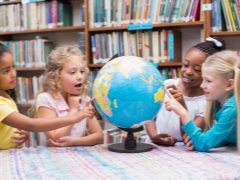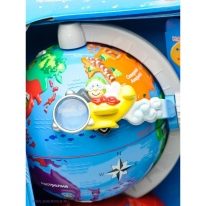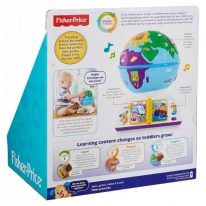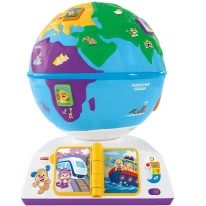Learning globes
The globe is an integral part of the school curriculum in geography, which allows us to more clearly imagine the location of various objects on the surface of the globe. At the same time, the globe, unlike the book, provides relatively little information, apart from the general outlines of the boundaries, the largest cities and capitals. However, modern technologies have already reached here, so now the learning globes have a lot of useful information, and they can also submit it in a fun way.
Functions
There are several different models of training globes, each of which, in addition to the map of the Earth’s surface, can have a different set of functions:
- By hovering a special pointer on a particular geographical object, the main information about this object is given out by voice, both in Russian and in the main foreign languages, which makes it possible to pull up another foreign language.
- It contains a huge amount of current information about states - in particular, their area and number of people, data on state languages, political structure, features of the national economy and local currency, and much more.
- Able to tell a lot about the local culture and customs, about the history and sights, typical weather and the ecological state of nature at this point, as well as to report interesting facts about various geographical objects.
- Since much of the geographic information, especially that expressed in numbers, tends to change constantly, a good learning globe must be able to update its own databases. Usually this possibility is realized through connecting the device to the computer via a USB cable.
- Some models also contain audio samples from a particular country — for example, recorded speech in the official language, or sounds made by common local animals.
- Such a product can be focused not only on children attending school, but also on university students, and on people who simply don’t like souls in geography. All three categories of users, one way or another, are interested in a certain game moment, which allows to check their own knowledge. That is why many electronic geoids are equipped with quizzes or special games.
The principle of the implementation of the gadget may differ slightly from model to model, but the set of functions, in general, is standard.
Sometimes manufacturers accompany a geoid with an interactive book, which also contains additional information. This may include information about industry and minerals, flags and anthems of various countries, photographs of dishes from national cuisines, dinosaur paleontological data and maps of geographical discoveries, as well as maps of the Moon and the Solar System with accompanying information.
How to help in the development of the child and what to teach?
It is no secret that the more a person knows about other countries, peoples and cultures, the wider his outlook. By virtue of his age, the child hardly had time to see the world, and such a gift would greatly contribute to the fact that he received certain knowledge about distant lands. Again, an expensive product is designed, including for students, that is, the data here are quite serious, and their number is comparable to a very thick book on geography.
If we reject the level of spiritual growth and focus on the fact that such a product can give a useful child, then the following should be highlighted:
- Certain knowledge of geography is accumulating, which will have a good effect on school grades and on the ability to tell something interesting.
- To work with small objects on the surface of the globe, it is necessary to develop good manual dexterity; in the process of learning, it is possible to significantly train both motor skills and coordination of movements. However, if a child is already going to school, then in this respect the globe is unlikely to give him something new.
- Learning the globe is a rather interesting conversationalist, so the child slowly gets used to the idea that he doesn’t necessarily need other people in order to have fun.
- In the process of learning, the craving for research activities is enhanced, and growing curiosity can be directed to the right direction.
- A large number of acquired knowledge and thoughtful tasks contribute to the development of logical thinking, which allows to sort information in the right way with the aim of better mastering it.
- An additional bonus to all of the above will be a more vivid imagination of the baby.
How to play?
Actually, useful geographic information can be obtained from various sources, and the high popularity of these gadgets is largely due to the presence of games in them, which differ from any other analogues - a clear link to the globe. This contributes to better learning and greater interest of the child in what is happening.
Again, the game concept of different models may look completely different, and the leader is probably the French firm Vtech, whose geoid offers a choice of five different game variants at once. We will consider them in more detail:
- Studying the globe. Represents the movement of the pointer in the form of a plane on the surface of the globe in a free mode. “Stops” at one place or another will provide certain information of a geographical and cultural nature.
- Linguistics. In the study mode, the device provides data on the languages spoken by the largest nations of the world, and even allows you to listen to a sample of speech in a given language. In the "New Friends" mode, the geoid, on the contrary, asks questions related to languages, and the host's task is to guess where on the planet they say that.
- Answers on questions. In this mode, the toy gives the child any tasks related to the information offered by the device, most often - to find one or another object on the map.
- Journey. In this case, the globe simply calls its operator a specific sequence of geographic objects that must be “visited” strictly in the specified order, without straying from the route.
- Music. This mode was created specifically to acquaint the child in more detail with the musical traditions of the peoples of the world. This is one of the most favorite modes of children, because in many ways it is entertaining. This option is designed for the youngest children, there is not so much information here, so the emphasis is placed on a large number of game modes.
If we talk about more serious models, designed, among other things, for experienced adult users, then the version of the game there looks more like a quiz, including with real, complex tasks.
Popular models
Contrary to the seemingly identical principle of operation and purpose, globes may have completely different implementation principles, affecting not only the cost of the product, but also its conformity to one or another target audience.
Vtech and Fisher Price
A vivid example of teaching globes for young children are the models of the Vtech and Fisher Price brands we have already reviewed. In fact, the amount of truly geographic information here is quite small. Such products are focused on preschoolers, starting from the age of one and a half years.
The lack of numerous data is due to the temporary inability of the target audience to understand and assimilate it, and it is compensated by various game modes, the task of which is to try to instill in the child an interest in geography and knowledge of unknown countries.
With all its advantages, devices of this type lose their relevance at a very early school age, and even look very naive in the first geography lessons.
For details on these models, see the following videos.
Intelligate
The interactive globe has a completely different purpose, a vivid example of which is the Russian Intelligate model. It is possible to teach children by it, but at the same time it is designed even for a rather meticulous geography lover who needs a sea of very different information, and always relevant. No matter how hard the authors tried to stuff more information into the geoid itself, they still were not satisfied with the end result, so this model comes with a little book that gives a large amount of visual information.
Due to the USB port and constant support on the official website of the manufacturer, the product database never becomes outdated, there is always only fresh information.
With the encyclopaedic nature of the knowledge offered, it is not surprising that the gadget in quiz mode asks quite serious questions that could stun many adults.
A gift of this type is relevant not earlier than entering the school, but it generally does not have an upper age limit for use.
Plain Globe
From the list of trainers it would not be entirely fair to exclude an ordinary globe. It may not look so exciting, and the text information on its surface is not so much, and even it is never updated, but in terms of cartographic accuracy it is the unequivocal leader. In addition, this option is much cheaper than any of its electronic counterparts, so that you can “update” it just by buying a new one over time.
Breaking or losing it is not so pitiful as in the case of gadgets, which means that children will be able to take it with them to school - especially if the compact size allows it. Again, adults can use this product with success.
Reviews
You rarely find a device or a device that everyone would like, but learning globes are from the category of such things. Of course, certain disadvantages are also indicated. Most often we are talking about the high cost and comparative primitiveness of the most childish models, but nevertheless positive moments prevail.
In many ways, consumers like the toy because of the originality of the idea itself and the overall color.
It is noted that such products usually take into account the basic requirements for children's toys, in particular, the use of only high-quality non-toxic materials. Positive evaluation has won and voice.
The general tone of the reviews is such that if there is an opportunity to spend money on this rather expensive pleasure, then it’s worth buying it. If we talk about expensive interactive globes, then they are generally regarded as a guide, useful for the whole family.
You will learn more about learning globes in the following video.





































